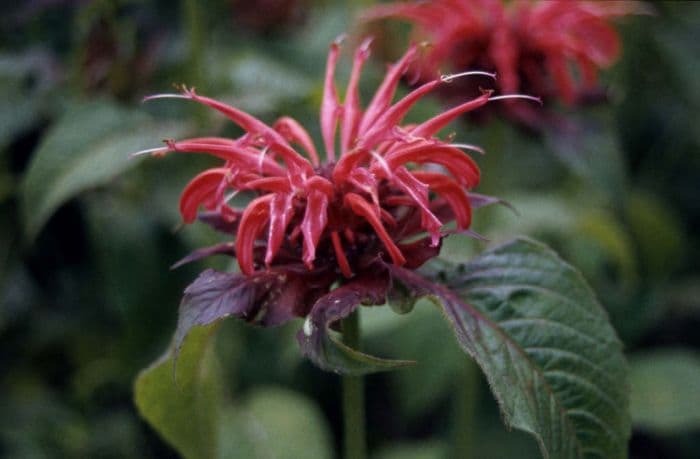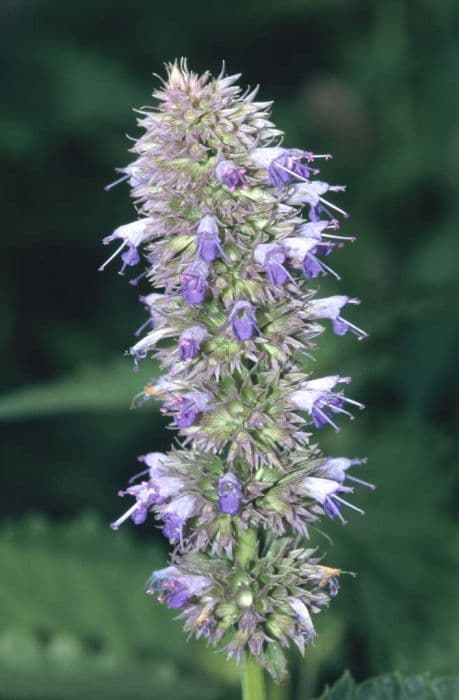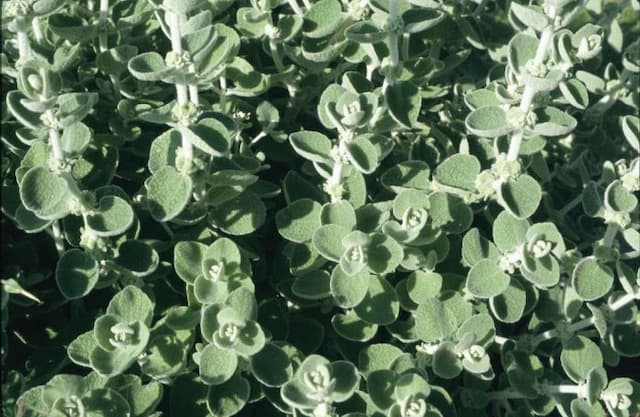Bergamot Monarda 'Adam'

ABOUT
Monarda 'Adam', also known as bee balm, is a perennial herb with a distinctive and attractive appearance that makes it a favorite in gardens. The plant is known for its vibrant flowers, which are typically a bright, purplish-red hue but can also come in a range of other colors, such as pink, white, or lavender. These flowers are tubular and are arranged in a dense, cluster-like formation at the top of the stems, reminiscent of a firework display, giving the plant a highly decorative effect. The foliage of bee balm is also quite attractive, with leaves that are a bright green color, lance-shaped, and have a somewhat serrated edge. The leaves are arranged oppositely along the square stems, a characteristic of plants in the mint family, to which bee balm belongs. When the leaves are crushed, they often emit a pleasant fragrance, which can be reminiscent of mint or citrus, contributing to the plant’s sensory appeal. Bee balm is not only notable for its appearance but also for its attractiveness to pollinators such as bees, butterflies, and hummingbirds, which are drawn to its striking flowers and the nectar they provide. This makes it not just a visually appealing plant for gardeners, but also an important one for supporting local ecosystems and biodiversity.
About this plant
 Names
NamesFamily
Lamiaceae
Synonyms
Bergamot, Bee Balm, Horsemint, Oswego Tea
Common names
Monarda 'Adam'
 Toxicity
ToxicityTo humans
The Monarda 'Adam', commonly known as Bee Balm, is not typically considered toxic to humans. No severe toxicity resulting from ingestion of any part of the Bee Balm plant is widely reported. However, as with any plant, individual allergies or reactions can occur, so it's always wise to exercise caution and not consume plant parts unless they are known to be edible and safe.
To pets
The Monarda 'Adam', or Bee Balm, is also not known to be toxic to pets. It is not listed among the common toxic plants for animals such as cats and dogs. Therefore, ingestion of Bee Balm is unlikely to cause serious harm or poisonous symptoms in pets. Always monitor your pets for any signs of individual adverse reactions and consult with a veterinarian if there are any concerns with ingestion of plants.
 Characteristics
CharacteristicsLife cycle
Perennials
Foliage type
Deciduous
Color of leaves
Green
Flower color
Pink
Height
2-3 feet (0.6-0.9 meters)
Spread
2-3 feet (0.6-0.9 meters)
Plant type
Herb
Hardiness zones
4
Native area
North America
Benefits
 General Benefits
General Benefits- Attracts pollinators: Monarda 'Adam,' commonly known as bee balm, is known to attract bees, butterflies, and hummingbirds, which are important for pollination.
- Aesthetic appeal: With its vibrant flowers and pleasant scent, bee balm adds color and fragrance to gardens and landscapes.
- Culinary uses: Some parts of bee balm can be used in teas and as an herb, adding a unique flavor to culinary dishes.
- Drought resistance: Once established, bee balm is relatively drought-tolerant, requiring minimal watering in well-drained soils.
- Easy to grow: Bee balm is known for being easy to cultivate, making it suitable for gardeners of all skill levels.
- Soil adaptability: It can thrive in a variety of soil types, although it prefers moist, well-drained soils.
- Naturalizing effect: Bee balm can spread and naturalize in an area, filling out garden spaces and creating a lush look.
- Deer resistance: Bee balm is generally resistant to deer, which can help to prevent damage to your garden.
 Medical Properties
Medical Properties- Antiseptic: Monarda, also known as Bee Balm, contains thymol which is an antiseptic compound.
- Carminative: It has been traditionally used to relieve flatulence and bloating.
- Diaphoretic: Bee Balm has been used to induce sweating and potentially aid in fever reduction.
- Antimicrobial: Components in the plant are suggested to have antibacterial and antifungal properties.
- Sedative: There is anecdotal evidence of its use in calming nerves and aiding sleep.
- Digestive aid: It is said to help with digestion-related issues.
- Anti-inflammatory: Bee Balm may have anti-inflammatory properties that can reduce irritation and inflammation.
 Air-purifying Qualities
Air-purifying QualitiesThis plant is not specifically known for air purifying qualities.
 Other Uses
Other Uses- Companion planting: Bee Balm can be used in the garden to attract pollinators such as bees, butterflies, and hummingbirds, which can improve the pollination of vegetables and other plants.
- Natural dye: The leaves and flowers of Bee Balm can be used to create natural dyes for fabrics or paper, producing a range of colors depending on the mordant used.
- Flavoring for foods: Bee Balm leaves can be minced and used to add a unique flavor to dishes such as salads, pasta, or used to infuse honey.
- Aromatic potpourri: Dried Bee Balm flowers can be included in potpourri mixes to add fragrance to a room.
- Decorative garnishes: Fresh Bee Balm flowers can be used as edible garnishes on cakes, desserts, and cocktails for their color and subtle minty flavor.
- Culinary herb: Bee Balm can be used as a substitute for oregano or thyme in cooking due to its similar taste profile.
- Landscape design: The vibrant flowers and foliage of Bee Balm make it an ideal choice for ornamental purposes in garden borders or as a focal point in a perennial bed.
- Homemade cosmetics: Bee Balm petals can be infused in oils to create natural perfumes, creams, or balms for the skin.
- Tea blend ingredient: Bee Balm leaves can be combined with other herbs to create personalized tea blends.
- Floral crafts: Bee Balm flowers can be incorporated into floral arrangements, wreaths, and other craft projects for their beauty and fragrance.
Interesting Facts
 Feng Shui
Feng ShuiThe Bee Balm is not used in Feng Shui practice.
 Zodiac Sign Compitability
Zodiac Sign CompitabilityThe Bee Balm is not used in astrology practice.
 Plant Symbolism
Plant Symbolism- Attraction: Monarda, commonly known as Bee Balm, attracts pollinators such as bees, butterflies, and hummingbirds, symbolizing allure and magnetism.
- Healing: Bee Balm has been used in traditional medicine for its antiseptic properties, representing health and healing.
- Balancing: The plant is known for its balance of aromatic leaves and vibrant flowers, which can symbolize equilibrium in life.
- Good Luck: In some cultures, Bee Balm is considered a good luck charm, offering protection and good fortune to those who have it.
- Happiness: The bright flowers of the Bee Balm bring joy and happiness, and are often linked with positivity and brightening one's mood.
 Water
WaterThe Bee Balm (Monarda 'Adam') should be watered thoroughly, ensuring that the soil remains consistently moist but not waterlogged. During the growing season, water the plant deeply once or twice a week; this will depend on the weather conditions, with more frequent watering necessary during hot, dry spells. A general rule could be giving the plant about 1 inch of water weekly, which would roughly translate to about 0.6 gallons for an average-sized plant. During the winter months, reduce watering significantly but do not allow the soil to completely dry out.
 Light
LightThe Bee Balm prefers full sun to partial shade. It thrives best when it receives at least 6 hours of direct sunlight per day. The ideal spot for Bee Balm would be in a garden bed that gets ample morning sunlight with some afternoon shade, as this can help protect the plant from the intense heat of the late day.
 Temperature
TemperatureBee Balm is hardy and can endure temperatures as low as -20°F, which would be its minimum survival temperature. At the other extreme, it can tolerate high summer temperatures well into the 90s°F. However, the ideal growing temperature would be between 60°F and 70°F for optimal growth and flowering.
 Pruning
PruningPruning Bee Balm is important to promote vigorous growth and prevent diseases by enhancing air circulation within the plant. Deadhead spent flowers regularly to encourage continued blooming. Cut the plant back to the ground in late fall after the first frost to clean up the garden and prepare the plant for winter. Bee Balm may also benefit from division every 3-4 years to maintain its vigor.
 Cleaning
CleaningAs needed
 Soil
SoilBee Balm 'Adam' thrives in fertile, well-draining soil with a pH between 6.0 and 7.0. A soil mix of loam, compost, and a little sand or perlite to improve drainage is ideal for this plant.
 Repotting
RepottingBee Balm 'Adam' does not typically require frequent repotting, as it is generally grown as a perennial outdoors. Repotting may be done every 2-3 years to refresh the soil.
 Humidity & Misting
Humidity & MistingBee Balm 'Adam' prefers moderate humidity levels but is adaptable to the humidity found in most garden environments.
 Suitable locations
Suitable locationsIndoor
Ensure bright light, consistent moisture.
Outdoor
Full sun, well-drained soil, space plants.
Hardiness zone
4-9 USDA
 Life cycle
Life cycleMonarda 'Adam', commonly known as Bee Balm, begins its life cycle when seeds are sown in spring after the last frost, and they germinate in warm soil. Following germination, the seedlings develop into young plants with distinctive fragrant foliage and square stems indicative of the mint family to which they belong. As the plants mature, they produce clumps of upright stems and in summer, vibrant tubular flowers bloom, attracting pollinators like bees, butterflies, and hummingbirds. After the flowering period, the blooms fade and the plant sets seeds, which can be collected or allowed to fall naturally to encourage self-sowing. In autumn, the foliage may die back, and the plant enters a period of dormancy over the winter. With the return of warm weather in spring, the perennial Bee Balm regrows from its root system to start the cycle anew.
 Propogation
PropogationPropogation time
Spring-Early Summer
Propogation: Monarda 'Adam', commonly known as Bee Balm, is best propagated by division in the spring or autumn. To propagate Bee Balm by division, dig up a healthy, established plant and carefully separate the root ball into smaller sections, ensuring that each section has a good amount of roots attached. These divisions should then be replanted into well-prepared soil, maintaining the same depth they were growing at originally. Ample watering after replanting is critical to help establish the new divisions. The divisions will typically start to show growth soon afterward and can be expected to bloom the following growing season. This method effectively expands your Bee Balm collection while also rejuvenating older plants that may have become too crowded.









